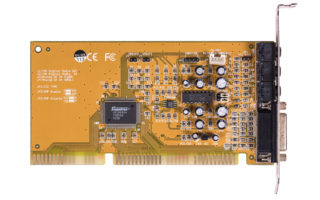
I always liked these kinds of misfits and underdogs and see how they fare against their “better” competitors. This is one of the cheapest cards I’ve tested, so far. I couldn’t find how much it cost back in the day, but it couldn’t have been much, by the looks of it. It’s a simple card with HT1869V+ chip, which is essentially C-Media CMI8330, which is an OPL3 clone. When I was looking for some information online, I haven’t found any other sound card with this chip. It seems to me like it was used only by some motherboards as an on-board sound card and not by so many either. There may be a reason for that. But we’ll see.
This is actually the first time I’ve laid my hands on one. I didn’t know something like that even exists, until I bought it couple of weeks ago. I’ve already put the card to the test in my previous OPL3 comparison video. It seemed like compatibility wasn’t an issue with this card, but I needed the card only for MIDI playback. This time, I’m gonna do proper tests.
Let’s have a look at its appearance and connectors first. There are 4 connectors on the back plate, Line In, Mic, Speaker Out and Game Port. There are no separate jack connectors for line out and speaker out, there are jumpers on the card that either enable or disable card’s amplifier. There are also SPDIF in and out connectors and two connectors for CD audio. The last jumper is for setting up MIC type. There is no PC speaker input, but I don’t think it matters, nobody uses PC speaker anyway. What is quite unfortunate, however, there is no waveblaster connector, so if you’d want to use some kind of wavetable daughter board, you’re out of luck.
Installation is pretty easy. I used DOS drivers for CMI8330, I just run the installation program, pressed enter key couple of times and that was it. It updated autoexec file automatically, and after the reboot the card sprang to life.
The card is a bit quiet with disabled amp, so I bumped master, wave and FM volumes up to the max and disabled all unnecessary features, that I didn’t need for gaming like line in and mic. Another weird behaviour was its volume levels in various games. Every game has its own volume level and thus some games are louder than others. With this card, sound effects volume is acceptable, but FM volume differs from game to game, most games are alright, but some are unbearably quiet. So, I had to lower wave volume in some games to make it even.
The installation program installs also a volume mixer, where you can find a loudness option, but enabling it didn’t do much. It gained about 6dB, but also some more noise. Another option there is 3D surround sound. I wouldn’t call it a 3D sound per se, it’s more like a reverb.
Another problem with the card I noticed right away, is its shielding. It’s prone to an outside interference and it sends out anything it grabs on the way. I wouldn’t call it a stellar performer, but it’s not that bad either. Unfortunately, when I wanted to record the noise caused by the interference, I couldn’t replicate it, after I cleaned it up. On the other hand, it may actually be a good thing, not to be able to make it sound worse on purpose.
Sound Pro is compatible with Windows Sound System, Adlib and Sound Blaster. It’s not unusual, what is quite interesting though, is its compatibility with Sound Blaster 16. Sound Blaster clones are usually compatible only up to Sound Blaster Pro. Since the card’s FM is so quiet, I had to boost the volume up for some games, but it introduced lot of noise. Well, the very first game Alone in the Dark and its own test detected only Sound Blaster and didn’t allow me to use Sound Blaster Pro. But to be fair, it doesn’t work with actual Sound Blaster 16 either.
To my surprise, it worked perfectly in every game I tested, it even worked in Space Quest 5, which almost never works. If the game included Sound Blaster drivers, it worked every single time and what was even more surprising, was the compatibility with Sound Blaster 16, which also worked in every game I tested. Same goes for Adlib and Windows Sound System, if the game included these drivers, it just worked. Underdog or not, it’s the best card in terms of compatibility so far. I tried many other games that I didn’t include in my test and all of them worked.
Noise level is quite alright, but and it’s a huge BUT, in some games the FM is so quiet, that you need to lower the wave volume and crank up the volume on your amplifier, and in a case of Heroes of Might and Magic for example, you’ll get horrible noise. If it’s had wavetable connector, it could’ve been used for MIDI and the card for sound effects, it would be pretty good, but this is not. Aside from this issue, its FM synthesis is decent, nothing special, but it’s decent, at least to my ears. I’m sure there is somebody out there, who prefers this to the Yamaha’s OPL3.
And there you have it. This is the only card that works in every single game. Sound quality is good, FM is good, but the issue with the quiet FM and missing waveblaster connector put this card at the bottom of my list.
